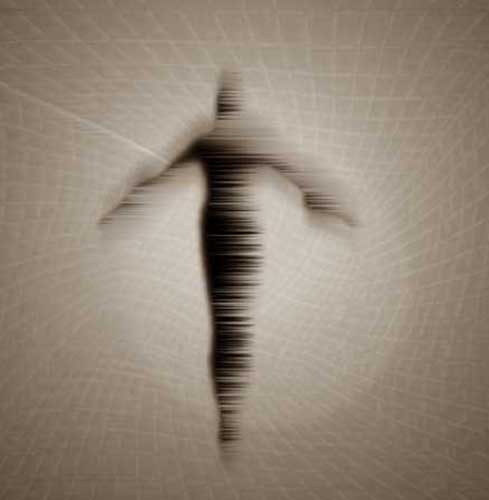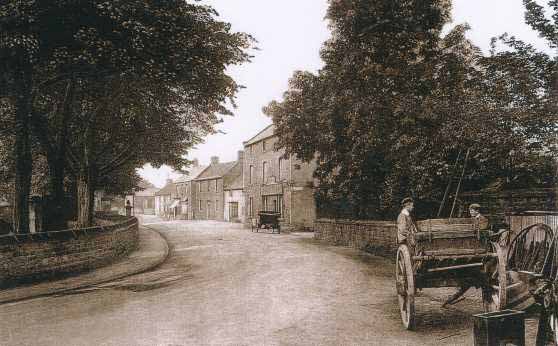

I discovered that I had been transported back through time into a world where everything appeared to me as sepia toned.
In my right hand I held a flat stone, approximately 3 inches square. The top of the stone was inscribed with something that looked like part of the symbol I had touched when I entered the portal into this World of Sepia.
The stone seemed to have broken in half on one side showing only half of the symbol. I wondered if this had happened by accident or was there a 'method to this madness.'
Realizing there are no 'accidents,' I assumed that finding the other half of the stone was part of my journey through time.
In my left hand I still held aunt Catherine's camera which seemed to have come through with me. Was the camera part of this? If so, in what way? My mind was filled with many questions as I stood there gazing at the wonders around me.
I turned to look for a portal of some kind to find my way home, but I saw no way out. Was I to remain trapped here forever? I searched my soul and did not feel that would be the case. Perhaps this is the place I would take that most important photo, the one that would affect the destiny of humanity. One thing remained obvious, I had come to this place for a reason and it was connected to this stone and my camera.
The palette of everyday life took some visual adjusting as I watched strangers in old-fashioned clothing move slowly past me. There were horses and buggies and old fashioned street lamps.
I looked up at the street signs hanging on chains from a pole on the street corner on which I stood. One sign read: Trinity Place. The sign adjacent to it read: Liberty Street.
At that moment I realized that I had time traveled to the area which would be the future location of the Twin Towers.
My attention focused on a familiar landmark which stood before me as I walked down the street . . . There was Trinity Church. Was I being told that I was protected or guided by a higher force?
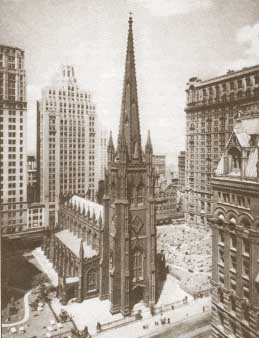
A large overhead clock outside of a bank, read: 9:00. People were hustling about beginning their daily activities on this bright sunny day that felt like summer.
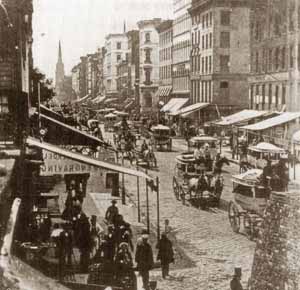
I walked into the cobblestone street. My attention was riveted as a horse and carriage came down the street, the driver shouting at me to move aside as I darted out of the way.
As passerbys stopped to stare at me, I realized I was out of place with my 21st century clothing. A woman in pants? Totally unexceptable. I passed a storefront window and gazed at my reflection realizing that I still looked like Samantha Stone circa 21st century, wearing jeans, T-shirt, and sandals.
The first order of business was to get new clothes, but ... I realized the money I had in my pocket wasn't accepted in this timeline. Don't you suppose they took credit cards? I would have to do some creative thinking.
I walked into a store that looked like an old fashioned general store.
Catching a glimpse at a newspaper I noticed that it was one of New York's financial papers The New York World.
The date read: Tuesday, August 11, 1885
The main headline read:
ONE HUNDRED THOUSAND DOLLARS! TRIUMPHANT COMPLETION OF THE WORLD'S FUND FOR THE LIBERTY PEDESTAL
We are grateful to the efforts of a man named Joseph Pulitzer in raising the funds for this project.
While the work of building the statue has been in the hands of the French the work of creating the base and pedestal for the statue was left to America. The federal government has created a star-shaped fort on Bedloe's Island. It is on top of this fort that the statue will stand. We now have the money to build the base and pedestal on which the statue will rest. Richard Morris Hunt will design the pedestal. Engineer named Charles Pomeroy Stone will design the foundation and assembly of the statue.
I couldn't believe what I was reading. Charles Pomeroy Stone was a distant relative on my father's side, which also included aunt Catherine. I had done a genealogical chart after she died, so the names were still familiar. Could this really be the same man? I needed to find out more about him as he was my first clue to this mystery.
If this was the same Charles Pomeroy Stone, he would have lived in Egypt and might know about monolith I found. How exciting it was that he was building the base for the monument that would become a symbol of hope, freedom and liberty for the millions of people who would pass through New York Harbor and land at Ellis Island to begin a new life in America.
I suddenly realized the connection my family had played in laying the cornerstone for this symbol of liberty, and now, in my timeline, America had been attacked not far from this symbol of freedom - The Statue of Liberty.
My reverie was broken by a woman talking to me. She was about my age and spoke with an Irish brogue. Her voice was filled with concern as she asked if I was lost or needed assistance.
I told her that I needed to find a pawn shop to raise money. I realized that all that I had with me that was of any worth was my camera and a round locket with a diamond chip in the middle that Max had given me. I knew I could not pawn the camera as it was part of my journey, so reluctantly I would have to pawn the locket.
The woman was compassionate, most likely thinking I was crazy. She directed me to the Modell Pawn Shop, a few stores down.
I entered the pawn shop alone and was greeted by a burly man with a handlebar moustache who stared at me suspiciously. He wore black trousers and a light blue shirt, the sleeves of which were rolled up. His hair was black and parted down the middle. He looked quite comical in my estimation.
I walked up to the counter and looked inside. The items in the locked showcases spoke of ancient times and customs. I remembered having visited pawn shops in New York City looking for antiques, but for now, everything in my life seemed to be in reverse.
"Can I help you?" he asked looking at my camera. "Would you like to pawn that camera?"
"No!" I answered quickly and firmly, hugging the camera against my body. "I use it for work as a photographer."
"Work?" He seemed confused that I was a woman who not only worked, but was a photographer.
"This is what I would like pawn ... for the right price," I stammered, removing the locket.
He examined it thoroughly peering at the diamond through a jeweler's eyepiece.
"Are you sure about the camera? Haven't seen anything like it."
"Forget the camera!" I replied with attitude.
"Hmmm ... I will give you $10 for the locket!" he said firmly.
"Ten dollars!" I shouted thinking that in 2001 it was worth ten times that amount, not to mention it was priceless to me.
"Take it or leave it!" he shouted back, seemingly uncomfortable with me as a woman and the way I was dressed.
Coming from the 21st century I thought I knew how to negotiate a good deal, especially after having traveled in the Middle East.
"That diamond is flawless and the locket is 14 karat gold. Where I come from I could get at least $1,000 for it."
"Then may I suggest you go back where you came from, as you obviously are not from around here."
I started to walk to the door.
"Wait a minute!" he said. "Maybe we can work out a deal that will be satisfactory to both of us. You obviously are 'troubled' and can use some money. You must assure me that this locket is not stolen and no trouble will come to me from it."
"I can assure you sir, it is not stolen. It was given to me as a gift from my boyfriend and I would only part with it under dire circumstances."
He opened the locket and looked at the two pictures - one of Max and the other of myself.
"Handsome chap ... and you do seem like a nice lady. I will make you a better offer."
We bargained for several minutes and finally settled on $30.
He gave me a pawn ticket and and I gave him the locket.
I reflected on the fact that in one year I had gone from a struggling photojournalist to a millionaire and now had only $30 to my name! But I did have my camera and the stone.
As I walked away he came up to me and asked, "Do you want the pictures in the locket?"
"Keep them with the locket."
"Then you expect to return for them one day?"
I paused, not knowing how to answer that question. "Yes. One day I shall return for them. Until that time, please take care of my locket."
"You can count on me," he said. "By the way. My name is Jake . . . Jake Montgomery."
"Thank you Jake. I must go now. Can you recommend a lady's clothing store nearby?"
"There's a store just down the street to the right."
"Thank you," I said and walked out of the pawn shop, a heavy feeling in my heart.
I took one final look at the locket through the window watching Jake as he put in into an old black Wells Fargo safe.
I left the pawn shop and walked to the woman's clothing store. It was fun looking through the fashions which reminded me of a rummage sale in the Manhattan Thrift shop I used to frequent.
I purchased a white blouse, a long dark skirt with a bustle which made me laugh, undergarments that felt way too constricting, laced up shoes, and a purse in which to keep my money and the stone.
I tucked my long hair up with hair pins to match the hair style of the day.
The bill came to $4.40 which still gave me money for food and whatever else I would need.
I walked down the street experiencing life as a 1880's New York City woman, waiting for the purpose of this experience to unfold.
I stopped for breakfast at a small restaurant where I ordered two fried eggs, a fresh baked blueberry muffin with jam and tea.
I asked a rather friendly and chatty waitress about finding Charles Pomeroy Stone, but all she knew about him was what she read in his newspapers.
How cool it would be If I could access the internet, or call information if only for a moment, I thought. Get a grip Sam! This is 1885! There's no internet! You will be 'shown' another way!
The waitress returned with a newspaper mentioning Charles Pomeroy Stone.
"Is this the guy you're looking for?" she said. "I thought this newspaper might give you a clue!"
The New York World, of course, hopefully I could now find Charles.
"Thank you very much," I said. "Can I pay you for the newspaper?"
"No need! I read it already. It's all yours. Good luck finding with your quest."
Someone at The New York World would know how to find Charles. I quickly checked the address of the newspaper. The photojournalist in me went into full gear as I paid my bill, left a large tip, grabbed my camera and purse, and headed out the door.
I found a taxi, a horse and carriage, and asked the driver to take me to The New York World offices.
I was thrilled to take a carriage ride and look at the marvels of the city. What would Max say if he knew I was a time traveler?
The first glimpses of 'tall buildings' were everywhere. Elisha Graves Otis had invented the world's first safety elevator in 1852 as early skyscrapers were about to become the fashion.
One thing that has never changed about New York City is the never-ending expansion that one witnesses no matter where one goes. For the creative mind, this is enticing. There is always new construction and something old be restored or torn down to make way for the new. It is an never-ending cycle that personifies the evolution of humanity in one way or another.
Everything and anything could be found in New York, even in this timeline. This seemed to be the pattern and the pulse of the city from the beginning. There would always be those who would visit, or move to the city drawn by the energies of freedom, vision, and hope to create a new reality one that can only be manifest here.
My distant relatives had arrived on these shores from Europe, back in the 1820's. They came here with visions and built a future. Now here I was to hopefully meet one of the most famous members of the family.
I wanted to take pictures of everything but hesitated should I need to use the film later and had no way to get another roll. Catherine's camera, though old, still dated many years after this timeline.
The driver stopped the carriage in front of the offices of The New York World. I gave him 10 cents and walked into the building.
Everyone was busy rushing about, from going from one deadline to another. It felt good to be around others in my industry even if it wasn't the 21st Century!
I found Charles Pomeroy Stone's office but was told he was gone the day.
Here comes the synchronicity ... Joseph Pulitzer himself entered the office. He seemed annoyed about something and was shouting at someone walking with him about sending a photographer to take pictures of Charles Stone on Bedloe Island that afternoon. Apparently the photographer who was supposed to do the job had suddenly canceled and no one else was available.
As everyone stood around in a frenzy trying to locate another photographer, I suddenly came forward and said, "Excuse me! I'm a photographer. I'm looking for a job!" I wondered if was how Clark Kent felt the first day he came to the Daily Planet.
Freeze frame as everyone stared at me.
Mr. Pulitzer, a man in his 40's, paused, then looked up at me from behind thick glasses.
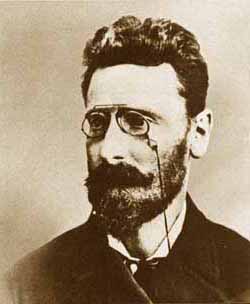
There was something about his eyes that connected for me, though I couldn't put it into words.
"What's your name?"
"Samantha Stone?"
"Did you say Stone?"
"Yes sir!"
"Any relation to Charles Pomeroy Stone?"
"The Charles Pomeroy Stone who is to build the foundation for the Statue of Liberty?"
"Then you do know who he is?"
"He is a relative on my father's side."
Pulitzer looked at my camera. "That's quiet a fancy camera you have there, young lady! I've never seen one quiet like it. I assume you have experience using it!"
"You might say it's ahead of its time, sir ... and I ... I am the best photographer in New York City," I responded confidently.
"You certain don't lack confidence, Miss Stone. Let's see how well you can live up to that title. I admire a spirited woman. I would like to hear more about you and this camera of yours. Follow me!"
We walked into his office. He asked me to shut the door behind us. Fear swept through me. Questions raced through my mind as he asked me to sit down on the chair across from his desk. Could I get away with this?
The dark paneled walls were an elegant backdrop for the massive mahogany desk and an impressive collection of old books and newspapers. An old Remington Number 1 typewriter sat on the desk. The heavy velvet draperies that covered the windows were tied back to allow cool air to enter on this hot August morning.
Pulitzer asked me about my work experience. When I told him about my global travels, he could hardly believe I had done so much traveling at my age, especially as a woman, living on a photographer's wages.
I changed the subject by telling him that I understood his passion for the Statue of Liberty project, and that he would be remembered in history books. He looked back at me not sure what to make of my statements, yet something within him knew that it was not by accident that I had come to his office at that point in time.
I guess stroking a man's ego, even in the 19th century, couldn't do any harm. I told him that I wanted to congratulate him on raising the $100,000 needed to complete the project.
Pulitzer told me that the project doubled the circulation of his newspapers in New York and St. Louis. He wanted the people across the nation to understand that the statue was a monument not just for New York City but for all of America. He believed in the invincible power of the United States and wanted to see that strength rooted in the souls of all of its citizens.
On June 15, 1885, the Statue of Liberty, inside 214 wooden packing crates, had arrived at Bedloe's Island, later to be called Liberty Island.
Pulitzer asked if I had visited the site where the Statue of Liberty was to be erected.
I could safely tell him that I had and what it meant to me as an American. My enthusiasm getting the better of me, I assured him that the project would be completed and the unveiling would occur on October 28, 1886. The day would bring one million New Yorkers to the festivities. Frederic-Auguste Bartholdi, President Grover Cleveland, members of his cabinet, as well as the governor of New York and his staff, the French ambassador would attend, accompanied by the French Committee.
The day would be a national holiday. Only people on wall street would work that day. There would be a parade. As the paraders passed by, the office boys from a hundred windows would unreel the spools of tape that record the fateful messages of the 'ticker.' The air would be white with curling streamers and something called a 'ticker ticker-tape parade' would be born.
He was thrilled at the prospect of what he considered my 'vision'.
I continued my monologue by telling him that the Statue of Liberty would be, for some time, the tallest structure in New York, for some time, reaching to a total height of 305 feet.
In years that would follow there would be flood lights at night and millions of visitors would come from all nations as We are the keepers of the flame of liberty; we hold it high for the world to see.
I went on talking with a passion explaining how New Yorkers would overcoming obstacles for decades in the future and how New York City would one day be filled with lights and tall buildings called skyscrapers. As the city would see many changes, its people would always stand together in days of trials and tribulations.
I paused and stared at Pulitzer across the desk.
He stared back at me his expression not eluding to his inner thoughts.
"I admire your creativity and vision, Miss Stone. These are admirable qualities. We need people with your passion to keep America strong; those who have the perceptions and determination to illuminate others. Go now, Samantha Stone, bring back the pictures of your vision.
Another man entered the office.
"Your first assignment is with Mr. Joesph Ames, one of my veteran reporters who will accompany you to Bedloe Island. He has an appointment to interview your cousin, Charles. You are, no doubt, aware that Charles is the chief engineer in charge of the entire construction project consisting of the foundation, the pedestal and the reassembly of the statue."
"Yes I am."
"Bring me photographs that will reveal the strength and power of the feminine Symbol of Liberty. Americans will need the visual impact of your pictures to fully understand what is taking place here. One day, my dear Miss Stone, women will have their freedom to vote and run for elected office. They will become great teachers, scientists and leaders in this great nation and will usher in a new reality. That is part of my vision."
"Thank you so much for sharing that, Mr. Pulitzer. I will remember your words always. Would you mind if we took one picture together?" I looked at him, almost flirting. "It would be wonderful for the folks back home!"
We stood in front of Mr. Pulitzer's desk as I showed Mr. Ames how to use the camera. They both seemed very impressed. I wasn't sure if I would ever return with the pictures I would take on this momentous day.
My salary would be $25.00 a week to start, which I quickly accepted though I had no frame of reference. I shook Joseph Pulitzer's hand to close the deal.
As we left his office, my heart raced at the very thought of seeing history in the making and meeting Charles Pomeroy Stone.
Mr. Ames and I took a carriage to the ferry which would take us to Bedloe's Island.
As we passed the area that would one day to be Ground Zero, events of 9/11 filled my mind. The fall of the Twin Towers was like the Earth erupting during a giant quake in which I was still in 'aftershock'. My consciousness moved to my timeline, as I remembered the pictures I had taken of the souls who had crossed over on September 11, 2001. Their faces filled my mind. I asked the carriage driver to stop so I might get out and take a picture of the area. Mr. Ames came with me and took a picture of me though he wasn't sure why it was of such importance as is was just land-fill.
The carriage pulled up to a dock along the waterfront that would one day be called Battery Park City. We got out and boarded the ferry.
As the ferry pulled away from the dock, I watched this unfamiliar Manhattan skyline grow smaller and smaller. Once again what had been so steadfast on the horizon was changing, the illusion of permanence only a fleeting reality. As a photographer, I knew reality was simply an individual perception, yet there was still that nostalgic feeling for the skyline of my past.
The trip to Bedloe's Island did not seem long as I was lost in thought watching the view and thinking about events of September 11, 2001 and what may have been occurring back home that threatened the security of all Americans and the city I love so much.
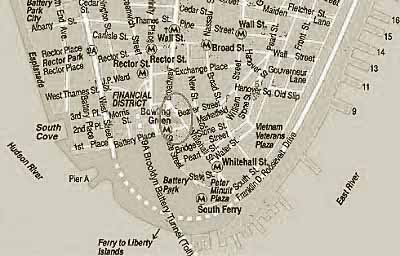
Mr. Ames and I arrived at Bedloe Island where we were greeted by two construction workers. One of the men escorted us to an area where Charles Pomeroy Stone was working on blueprints in preparation for laying the foundation of the Statue of Liberty.
Charles paused when he saw me as if trying to remember where we had met before.
"Do I know you?" he said walking over to us and shaking my hand.
"My name is Samantha Stone. I work as a photographer for The New York World."
"Samantha Stone ... Are we family?"
I looked at him almost afraid to tell him the truth.
"I believe we are."
Mr. Ames interrupted the conversation as it was time to start the interview with Charles.
We talked as we walked around Bedloe Island. Mr. Ames made notes and I took a few pictures, hoping to return with them to my timeline.
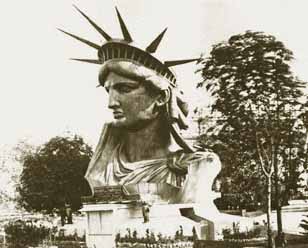
I could I hardly believe that here I was standing on the very site the Statue of Liberty ... the symbol for American democracy would be erected. Here I was, the day before the foundation was to be laid.
The interview was about the life and times of Charles Pomeroy Stone.
Cousin Charles turned out to be much more colorful than I had expected. A graduate of West Point, he had served in the military in the United States was a veteran of the war with Mexico and the Civil War. He had also worked as a banker, surveyor and engineer.
I was most excited to hear that he had been chief of staff in the Egyptian army, especially as I had found a monolith there.
After the interview Mr. Ames and I started back to the boat, but Charles asked that I stay a while to talk about family matters.
I wasn't sure how or what I would say, but I agreed.
Mr. Ames took the ferry back to Manhattan. I was to meet him at the newspaper the next day with my pictures. I wasn't quite sure how I was going to handle that either. It was all about 'going with the flow'. For the moment the meeting with Charles seemed most important.
Charles and I sat alone under a shaded tent to block out the heat of the sun's rays.
I wished I was back in my timeline wearing shorts, T-shirt, and sandals. I wondered how woman ever survived wearing bustles and corsets in the heat. Oh well, I adjusted my bustle and sat down.
Looking deadly serious, Charles turned to me and said, "Tell me Miss Stone ... just who are you?"
